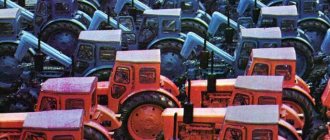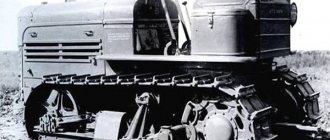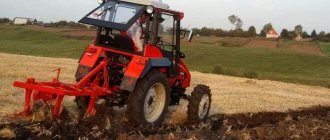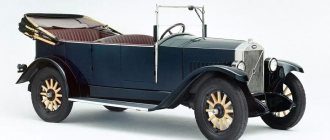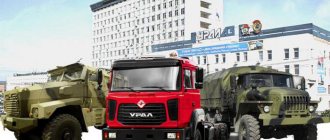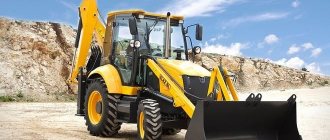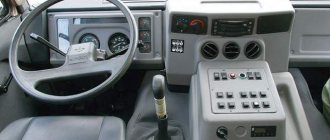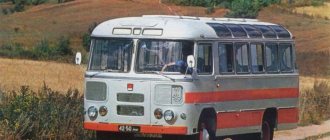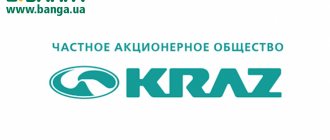One of the most popular tractor brands that farmers are looking for on the Internet and, in particular, on the Technoradar website is Kirovets. This is quite simple to explain - Kirovets tractors rightfully occupy a leading position in the Russian tractor market.
Buying a Kirovets tractor or buying a Versatile tractor (now Rostselmash) or buying a John Deere is an excellent investment in the development of your farm. In this review, we will go through all the main generations and models of Kirovets tractors and look in more detail at modern models.
A little history of the Plant
Kirovets tractors were and continue to be produced in St. Petersburg. Until the mid-90s of the last century, the manufacturing plant was called the Kirov Plant, then the Kirov Plant became a holding company and separated its tractor production into a separate enterprise, which is still called the St. Petersburg Tractor Plant (hereinafter PTZ) (https://kirovets-ptz. com).
The Kirov Plant is a truly legendary place for Russian mechanical engineering. Founded in 1801, the company is now 221 years old and older than John Deere (1837). The formation and rapid development of this enterprise is closely connected with the personality of Putilov. You can learn more about the glorious history of the Kirov Plant on this page https://kzgroup.ru/companiya/istoriya/.
Briefly about important milestones in the development of the Kirov Plant:
- production of artillery cores
- production of steam locomotives
- Pop Gapon and Bloody Sunday
- artistic casting of cast iron for the city
- struggle for survival after a massive flood
- wagon production
- first Russian rail
- The first social facilities for workers were opened - hospitals, schools, gardens, parks, a library
- release of destroyers
- production of city trams
- revolution 1917
- start of production of the first Russian Fordson tractors
- start of production of the first Russian tanks
- defense of Leningrad during the Great Patriotic War
- transportation of part of the tank production capacity to Chelyabinsk
- nuclear icebreaker fleet
- production of Kirovets tractors - 1962
- production of tanks, chassis for artillery and air defense systems
- establishment of the enterprise after the collapse of the USSR
An amazing and heroic fate that is tightly intertwined with the development of Russia. A plant that deserves respect and attention.
Agricultural tractors Kirovets until 2002
Until 2002, St. Petersburg tractor manufacturers produced tractors of several generations. The changes in the models were quite smooth and evolutionary.
Separately, I would like to note that the fate of Kirovets included a number of models that never became serial. They, as they say in the world of the automotive industry, remained in history as concepts on the basis of which ideas were developed. We will not touch these cars in this review; they are mentioned in the table with all the models.
Let me remind you of the chronology of tractor production at this time.
| Model | 1962 | 1975 | 1980 | 1988 | 1995 | 2000 | 2002 |
| K-700 | |||||||
| K-700A | |||||||
| K-701 | |||||||
| K-701M | |||||||
| K-734 | |||||||
| K-744 | |||||||
| K-744A |
K-704 Stanislav
- Year of production – 2008 – present.
- Manufacturer – St. Petersburg Machine-Building Plant
- Engine power – 240-400 hp.
- Estimated cost – 5.4-6 million rubles
K-704 Stanislav is also a worthy successor to the legendary Soviet Kirovets brand. This powerful, energy-rich tractor copes with all the tasks that are posed for machines of this traction class. There are several other interesting features of the model
- Hydraulic steering system with priority valve. Reduces engine power loss by 5%, and for example an engine with a rated power of 400 hp. delivers efficiency as a 420-horsepower unit.
- One of the main features of the model is the ability to install a large number of various industrial equipment
- A large selection of engines for any task, and it is even possible to install a 600-horsepower engine thanks to the improved frame.
- Axles with increased efficiency and cross-axle differential locking function
In addition to the main model, the PMZ plant also produces several more tractor modules K-705, K-706 and K-710, which can be equipped with a wide variety of industrial and agricultural equipment.
Engine options:
| Model | Engine | Power hp |
| K-704-4R | YaMZ-238M2 | 240 |
| K-704-4R | YaMZ-238D | 330 |
| K-704-4R | YaMZ-7511 | 400 |
| K-710 | WD10G | 220 |
| K-710 | MMZ D-262.2S2 | 250 |
| K-710 | CS11CB320 | 320 |
K-700
The K-700 model became revolutionary for the Soviet, and world, tractor industry. Why for the world? Because at that time only a few tractor manufacturers had their first attempts to make similar machines, but as a rule they were not large-scale and for lower engine power, and some even without a cab.
So, what was so new in the Kirovets tractor? First of all, power and performance. The power of the Yaroslavl 12-cylinder engine was 210 hp. The mass-produced tractor of those times, used as the main one, was the tracked DT-54. The Kirovets K-700 tractor was almost three times more productive and more comfortable!
The wheel design of the tractor was also unique for the industry. This was not a classic tractor, in which 70% of the mass was on the rear axle. It was a more balanced solution - the weight distribution was 50 to 50 (almost). This circumstance made it possible to increase the adhesion properties of the wheels and thus increase traction capabilities. Of course, the size of the wheels had to be increased.
And ultimately, in order to control such a tractor, it was necessary to completely change its turning principle. Since the engine was too large to make a classic turn, the tractor was made articulated. This solution gave maneuverability comparable to classic cars and increased cross-country ability, which made it possible to easily get out of ruts. There were also disadvantages - it is impossible to work effectively in operations for processing row crops.
It was decided to leave this disadvantage to small classic tractors.
Machine operators fell in love with the K-700 tractor from the very first sight. It produces more output, which means the salary is higher, but there is also less vibration and noise than on tracked vehicles.
There is a legend that agronomists did not like him because he over-compacted the soil. I'm sure these are stories. The Kirovets puts no more and no less pressure on the soil than a MTZ tractor. Many people forget that pressure is the ratio of mass to contact area.
Areas of application of Kirovets, attachments
The K 700 family of tractors was originally intended for use in agriculture. However, potential was also seen in other industries. The machines are also used in the public utilities, industry, road and construction industries. Kirovtsevs are also used in forestry, as well as in military units.
Using various attachments and installations, tractors from the Kirov plant do an excellent job with all work related to soil cultivation, sowing and harvesting, help in removing snow on roads and industrial facilities, are used for laying power lines, installing lighting masts, and are engaged in loading and unloading. logs, transport artillery pieces.
All modifications of tractors have a single system for fixing additional devices - a separate-aggregate system. It allows you to control both the equipment itself and its individual mechanisms.
The following are installed on the rear of Kirov vehicles:
- rotary blades for snow removal;
- soil cutters;
- grabs for moving timber;
- plow;
- harrow;
- harrow-hoe;
- silo compactors;
- vibrating plates;
- holders for transporting pillars and pores;
- bulldozer blade;
- front loader bucket;
- fifth wheel coupling device.
By the way, a bulldozer blade can also be installed in front of the K-703.
K-700A and K-701
Models K-700A and K-701 became a logical continuation of the K-700 tractors. These tractors had significant differences from the K-700:
- power increase: K-700 - 220 hp, K-700A - 235 hp and K-701 - 300 hp
- The weight of tractors has also increased to increase traction forces
- removed the springs
- instead of one tank, two were placed on the sides to maintain a balanced weight distribution both at the beginning of the shift and at the end
- change in appearance
- the wheels became wider and larger in diameter - which led to an increase in the width of the tractor and the need for additional approval for access to public roads
- The hinge and half-frames have been strengthened - now you can place loading equipment on the rear half-frame
- and, perhaps, the most important change is that it is now possible to change gears without losing power within the range
- operating speed increased from 30 to 34 km/h
All changes were aimed at increasing the tractor's traction power and versatility.
With minor changes, the K-700A and K-701 machines were mass-produced until 2002! That is 27 years.
And one more fact - these tractors were exported not under the Kirovets brand, but under the Belarus brand, models 7100 and 7111. Google these machines. By the way, KhTZ tractors were also exported under this brand. Such decisions were made at the level of the state, which owned the monopoly on exports.
Description of technology and modifications
The K 700 tractor, especially its first modifications, received the nickname “humpback” because its hood had a peculiar, slightly trapezoidal shape directed forward. Modern Kirovets K 7M and K 5 also have a hood hump, although with rounded lines.
From the very first machines, the roof of the tractor cabin extended slightly beyond the dimensions. It's as if it's just put on top, like a cap or Panama hat. It remains this way to this day, of course taking into account modern requirements for design and aerodynamics.
The operator's workplace was always quite comfortable. Soviet vehicles, as well as industrial tractors and special equipment based on Kirovets, provide for placement of two people in the cabin, while the agricultural K-5 and K-7M do not have this. But they now have panoramic glazing, power and some aggressiveness in appearance.
The driver's seat of the reclamation machine is sprung, the control levers (and buttons, if we consider modern models) are conveniently located. The cabin has a heating and ventilation system that provides comfortable working conditions.
It’s better not to ask how much the K-700 tractor weighs. Its operating weight was 12 tons. At the same time, it withstood an axle pressure of 9 tons and could transport an eight-ton trailer.
The new generation Kirovets weighs from 10.5 tons to 16,630 kg. Although some special vehicles based on it exceed the 23-ton mark. Much here depends not only on the basic equipment, but also on the attachments.
K-701M
The next model released on the Kirovets ideology is the K-701M and its modification M1 (the name is just like the latest chip from Apple). The main difference between the machine and the previous ones is an increase in engine power and increased comfort for the tractor driver, primarily due to the return of the front axle suspension. Later it was taken as a basis when creating the K-702 and K-703 models - these are road construction and industrial machines.
Application of Kirovets tractors
The development of Kirovets tractors from the very first model was carried out in accordance with various climatic conditions. The tractor had to work in any conditions without loss of performance. New models were developed taking into account the climate and terrain. And if earlier Kirovtsy were used only in agriculture for plowing fields, now these tractors are considered universal.
Over time, the plant began to produce mounted equipment so that farmers could use one tractor for different jobs.
In addition, Kirovets tractors are excellent for road, construction and utility work.
Share
Failure of the strategy for developing foreign markets
It is worth mentioning that the post-Soviet era was marked by rather complex reform processes. It was necessary to rebuild the plant in all directions.
In the last years of the USSR, the Kirov Plant produced 20,000 Kirovets tractors annually. And immediately after the collapse of the union, the pace began to decline sharply. 5000, 3000 and now 1500 tractors.
In such realities, the plant management understands that production must be rebuilt to new volumes and to new technologies. It is necessary to look for new sales markets, because the domestic market was oversaturated with Kirovets tractors, the production volumes of which were inflated back in the Soviet era in the offices of ministries. Domestic agricultural enterprises, having become fully self-supporting, immediately realized that purchases were so frequent and in such quantities as previously not required. At the same time, new types of foreign equipment have become available to Russian farmers. Mostly not new, but used, but in very good condition and excellent quality.
At that time, the only possible place to expand sales volumes was export to capitalist countries. For export markets, the Kirovets tractor had a very strong advantage - an incomparably low purchase and operating price.
But there was also an important and insurmountable drawback. The level of technical solutions for controlling the gearbox and hydraulics of working equipment lagged behind the new European standards, but most importantly, the cabin did not meet the safety level.
To solve these problems, the St. Petersburg Tractor Plant, together with German partners, is producing a new series of tractors under the symbol K-734 and K-744. These machines are being adapted to new requirements and are being delivered. The first years were marked by high demand and interest. But alas, the technological degradation of the post-Soviet stage made itself felt and, unable to maintain the quality and reliability of the machines, tractors of this series ceased to be exported by 2000.
Petersburg Tractor Plant, JSC
Production of Kirovets tractors, special vehicles based on them and other agricultural machinery.
JSC "Petersburg Tractor Plant" is a subsidiary, which traces its history to the Putilov plant, founded in the capital of the Russian Empire in 1801.
Story:
The plant's history of producing tractors dates back to 1924, when the first Fordson-Putilovets tractor was produced, and is more than 80 years, which has allowed us to accumulate and generalize unique experience.
1934 - 1940 - The plant mass-produced more powerful Universal-1 and Universal-2 tractors. In total, almost 150,000 Universal and Fordson-Putilovets tractors have been produced since 1924.
In 1962, the plant assembled the first legendary K-700 “Kirovets” tractors, in 1975 – the first K-701, and since 2000 – the new generation K-744 tractors. In just 40 years, more than 467,000 Kirovets brand tractors rolled off the plant’s assembly line.
1964 - Serial production of Kirovets tractors was launched. On September 14, 1964, the first production K-700 rolled off the main tractor conveyor of the plant; more than 1,200 vehicles were produced during the year.
1975 - Second generation of Kirovets agricultural tractors: the first production K-701 (300 hp) was assembled. The 100,000th serial K-700 was produced.
1979 - The first generation of industrial tractors “Kirovets”: design documentation was developed and the first serial tractors K-703 (235 hp) were assembled as the basis for the manufacture of a complex of forestry machines.
1985 - Third generation of Kirovets agricultural tractors: the first production tractor K-701M (335/350 hp) was assembled. The 300,000th tractor was produced.
1989 - Second generation of industrial tractors “Kirovets”: production of road construction machines based on the K-702 industrial tractor (235/250 hp) began
1995 - The fourth generation of Kirovets agricultural tractors: the first models K-734 (250 hp) and K-744 (350 hp) were assembled for export. The 460,000th serial tractor was produced.
2000 - Fifth generation of Kirovets agricultural tractors: the first K-744R tractors were manufactured for the domestic market, the first pilot batch of K-745 (428 hp) was produced.
2001 - Since February 1, 2001, a complete transition has been made from the production of models K-700, K-701 and K-703 that no longer meet modern requirements and safety standards to mass production of new models K-744R (250/300/350 hp. )
2007 — Third generation of industrial tractors “Kirovets”: design documentation was developed and prototypes of the K-3060 front loader model with a lifting capacity of 6 tons were produced.
2008 - Concept tractor of a new generation of agricultural tractors "Kirovets": design documentation was developed and prototypes of the K-9000 models (354-516 hp) were produced.
2010 — Design documentation was developed and prototype models of the K-3080 front loader with a lifting capacity of 8 tons and the K-708 universal tractor module with an overall width of 2.5 m were produced.
2014 — A deep modernization of the Kirovets tractors of the K-744R series was carried out. This year marks 90 years of production. 600,000 tractors were produced, equipment productivity increased 20 times.
2015 — A new model of the new generation industrial tractor “Kirovets” was released.
2016 - A new generation gearbox was developed and released - the T5 automated gearbox with the Command Post control system.
2017 — A dump truck based on the K-708 was manufactured. A new series of loaders and universal road machines “Kirovets” K-708 has been released. The Kirovets tractor is 55 years old.
New era
Failure in the European market and the development of supplies, first of all, of used imported tractors to Russia threatened the very existence of the St. Petersburg Tractor Plant.
The plant management decided that salvation lay in updating the already Russian line of tractors, which had not been updated for 27 years. Now or never!
| Series, models | 2002 | 2014 | 2017 | 2018 | 2019 | 2020 | 2022 |
| K-744R | |||||||
| K-7 | |||||||
| K-7M | |||||||
| K-424 | |||||||
| K-525 |
Endless courts
Arriving at the plant, the new manager announced a policy of reform. First of all, he intended to unite into one all the subsidiaries, of which by that time there were 22, including the largest St. Petersburg Tractor Plant and Metallurgical Plant. At that time, the Kirov Plant had no debts; the group's consolidated revenue at the end of 2005 amounted to 9.134 billion rubles.
The change in management style resulted in losses in the management team.
At the end of 2005, Deputy General Director for Economics Yuri Borisov
, in the spring of 2006, the general director of Petrostal,
Valentin Zakharov,
. Both were considered one of the key figures in the structure created by Pyotr Semenenko.
The composition of the board of directors has almost completely changed, headed by the director of the St. Petersburg Tractor Plant Alexander Krikunov
.
Later it turned out that the changes also affected the owners of the Kirov plant. From the first days after the death of the general director, Tetramet, PTZ-Invest and Sigma-Invest, which were under actual management, began to undergo reorganizations. By 2009, as a result of several stages of purchase, sale and disposal transactions, about 35 percent of the shares of the Kirov Plant ended up at the disposal of companies registered in Cyprus.
In 2008, minority shareholders went to court for the first time regarding the revealed facts: they challenged 14 interrelated transactions for the alienation of 41.28 percent of the shares of the Kirov Plant. In the fall of 2009, the 13th Arbitration Court of Appeal declared the transactions invalid and left the plaintiffs the opportunity to search for and reclaim shares from unscrupulous purchasers. However, he refused to return the shares due to the liquidation of the intermediary companies through which the transactions were carried out.
The court materials say that the shares were withdrawn from the Kirov plant at a price of three dollars per share. And later they were resold through appraisal by intermediary firms at tens of times more expensive.
The court decision states that “in the actions of General Director Georgy Semenenko, who has an interest in the transactions, there is a sign of a “hostile takeover” of Kirov Plant OJSC by illegally obtaining the right to shares.”
After the decision was made, the struggle between majority shareholders and minority shareholders entered a new phase. Numerous retaliatory lawsuits followed, new lawsuits related to other episodes of the Kirov Plant transactions, and unsuccessful attempts to remove Georgy Semenenko from the post of general director. The court's decision did not stand up to review in cassation.
– Yakovlev and Ustinov disputed the transactions for the sale of shares in the enterprise, arguing that the general director did not have the right to approve them. Considering that their shares were distributed among approximately 10 holders on each side, they could go to court about a hundred times for the same issue - simply changing the places of plaintiffs and defendants. To date, they have lost all the courts challenging the transactions: the transactions were recognized as legal,” said Yegor Noskov.
In 2011, the Kirov Plant left the stock exchange. As stated in the commentary of the enterprise’s press service, this was dictated by “an extremely insignificant volume of transactions on the stock exchange for the sale and purchase of shares.” However, according to the representative of the minority shareholders, Petr Frolov, this was due to the need to hide accounting and corporate information from shareholders.
The Kirov Plant, whose history goes back more than 200 years, is one of the oldest and largest engineering and metallurgical enterprises in Russia. Photo: Alexey Danichev/RIA Novosti
His opinion is confirmed by the fact that after a couple of years the Kirov Plant stopped publishing consolidated financial statements. According to Pyotr Frolov, the company discloses contracts only to banks.
Since the start of the corporate dispute, Kirovsky Zavod has suspended dividend payments to shareholders. As Egor Noskov clarified, this is due to the fact that “mechanical engineering in Russia is a capital-intensive and low-margin field of activity, so profits are reinvested in the enterprise.”
K-744R
So the K-744 project was reworked from German to Russian realities, received a new index P (Russia) at the end and began to be offered to customers as a serial product in 2002. The decision, although belated, was correct. And it was even more correct to give a whole line of cars with power from 250 to 350 hp, then a few years later and 390 and 420 hp. This step fully coincided with the growing trend in tractor power and farm size.
The main differences between the K-744R series and the K-700A and K-701 are in appearance, the presence of a sprung front axle, operator comfort (central tractor seating position, heater and air conditioning, additional noise and vibration protection), and, of course, a built-in power cab frame to protect the operator from rollover, the presence of hydraulic options for working equipment with an axial piston pump and an enlarged fuel tank and the offer of a dual wheel option in the factory.
It should be said that the simplest configurations with simple gear hydraulic pumps were preserved for a long time.
One of the pleasant differences for customers was the use of Mercedes engines in the series on cars with a power of 354, 401 and 428 hp. Their main differences are greater efficiency, a wider tractor torque band, a larger torque reserve than the Tutaevsky motor and less noise and vibration.
For 14 long years, the series of these tractors was modernized very slowly. And only in 2014 was it truly updated for the first time (during this time, competitors updated their lineup twice).
The tractor was updated mainly by redesigning the external appearance (to shout to everyone about the change) and updating the gearbox - the gearbox model was called T5, and its control system was called Command Post (moving away from the old multi-lever control system to modern buttons and shifters, as well as automating the processing of possible switching errors , increasing the service life of parts).
These changes in the series and the reforms initiated at the enterprise literally saved it from collapse and brought it to the leadership of its segment. According to various estimates, Kirovets tractors occupy about 50-60% of the market for tractors with a power of 300 hp or more.
Technical characteristics of Kirovets
With each new modification, the characteristics of the Kirovets changed. This applies not only to engine power. The engine, transmission, suspension, and cabin were changed.
Engine
The main supplier of engines for Kirovce is Yaroslavl. Not only YaMZ, but also TMZ. Tutaevsky engines with a power of 350 hp. installed on industrial tractors, welding units based on them and the K 7M agricultural tractor. The latter, by the way, can be equipped to order with a Mercedes or MTU engine with a power of up to 428 hp.
The main serial power unit is a Yaroslavl eight-cylinder diesel engine with a capacity of 235-250 hp. They are installed on most manufactured front loaders, wheeled bulldozers, and tractors. But the agricultural K-5 comes with the YaMZ-53645 inline six.
Fuel consumption depends on the load. On average it is 216 g/kW hour for modifications of YaMZ 238ND.
Transmission
The Kirovts transmission depends on the purpose of the tractor, but in almost all modifications (with the exception of loaders) the gearbox has 16 forward speeds and 8 reverse speeds.
Wheeled bulldozers and tractors are equipped with a four-speed manual transmission with 4 additional low and high gear modes. Thanks to this, gear shifting occurs in some cases without loss of power. The maximum speed of the Kirovets K 703 forward is 33 km/h, backward – 24 km/h.
Agricultural machinery of the Kirov plant is equipped with more modern gearboxes - these are automated hydropneumatic boxes T5 and T7 with a Commandpost-4 control system. They have optimized gear ratios and installed improved transfer cases for more efficient operation of the equipment. Control is carried out using a joystick.
Chassis
Kirovets tractors are equipped with two drive axles. The front one has permanent drive, the rear one can be disabled. They are equipped with an inter-wheel self-locking differential.
The front suspension of the K 703 is leaf spring. The bridge is equipped with two half-rests resting on the frame. This allows you to reduce the vibration load on the tractor and operator components. The rear axle is rigidly fixed to the frame.
The brake system is shoe, with pneumatic booster.
Fire, K-424 and K-525
In July 2022, a major fire occurred at the Plant, which practically destroyed the home production of the PPC. Her recovery took two years. In the meantime, the production of the gearbox itself was located in many factories, and the assembly was still PTZ. But of course, all its components and parts were greatly in short supply due to this.
It seems to me that it was precisely this circumstance that did not give us a chance to install our own gearboxes on the new product. Thus began the fate of the new Kirovets tractor model under the symbol K-424. We will return to this circumstance later.
The K-424 is classified as a tractor with an articulated frame with a power of 240 hp, it replaced the legendary K-700A. The St. Petersburg Tractor Plant intended to replace thousands of old machines of the K-700 family with its new product.
The car turned out to be interesting and long-awaited. On the one hand, there are thousands of old machines of a similar type, on the other, the only available alternatives are the machines of the Kharkov Tractor Plant, which were practically not produced at that time.
What worked in the tractor and what didn’t?
The layout brings together the best practices: a comfortable and protected cabin, an engine with a common rail, tanks on the sides, a new-generation gearbox control system and, for the first time, serially installed electro-hydraulics and a power and position control system for the hitch in the base. And with all this, the tractor entered the transport envelope, which does not require approval when traveling on public roads. The tractor has surpassed the older K-744R series in terms of its parameters and modernity.
What didn't work? The most important thing never happened. In conditions of shortage, a ZF gearbox was installed with a small set of gears (only 3 in the operating range). In agriculture, such a box will not allow it to be effective in a wide range of changing conditions - different fields in terms of soil, humidity, density and topography. And, besides, such a box did not have the opportunity to install a PTO. Which completely negated the idea of universality.
Of course, there is also the question of why the tractor in such a power range did not become row crop, why they did not switch to the classic layout. Now this class of tractors is ideal for both farmers and large agricultural holdings for cultivating row crops (corn, sunflower, beets). They don’t require enormous power, but they do need a simple system of linear movement along the rows. The question remains unanswered.
When the new restored gearbox workshop at the St. Petersburg Tractor Plant was launched and was able to produce large volumes of gearboxes, the plant completed production of the K-424 and began producing its new modification, the K-525, which was mainly distinguished by a reinforced frame and gearbox, unified with the K-7.
The new modification K-525 solved the problems of the K-424 transmission and began to enjoy increased demand, which the plant (as they say in the market) cannot keep up with.
K-714 Petra
- Year of manufacture – 2004 – present.
- Manufacturer – Special Equipment Plant
- Engine power – 240-420 hp.
- Estimated cost – 5.3 – 6 million rubles
PTZ is not the only worthy successor to the legendary Soviet tractor. Since 2000, the Special Equipment Plant in St. Petersburg began assembling the first models of its own production. In essence, this is the good old Kirovets, but in a new, updated and modern body. And the inside is just as simple and unpretentious, yet reliable and cheap to maintain. It is inferior in all modern features and options to tractors from PTZ, but it is cheaper and more accessible. But it has one interesting feature: its articulated frame without industrial support; together with the front balancer, this arrangement becomes more convenient to operate and more durable to use.
Currently, the plant already uses its own brand PETRA-ZST, but many still call them Kirovtsy. In total, the ZST plant produces two types of tractors. ZST 375 is a class 5-7 traction tractor with a wide choice of engines. All industrial models of the enterprise are created on the basis of tractors of this series. ZST 390 is an agricultural universal tractor more suitable for agricultural activities.
Engine models and options:
| Model | Engine | Power hp |
| PETRA-ZST 375 | YaMZ 238M2 | 240 |
| PETRA-ZST 375 | YaMZ 238ND5 | 300 |
| PETRA-ZST 375 | YaMZ 238D | 330 |
| PETRA-ZST 375 | YaMZ 65855 / TMZ 8481.10 | 350 |
| PETRA-ZST 375 | YaMZ 65857 / TMZ 8481.10-02 | 390 |
| PETRA-ZST 375 | YaMZ 7511 | 400 |
| PETRA-ZST 375 | YaMZ 6585-04 / TMZ 8481.10-04 | 420 |
| PETRA-ZST 390 | YaMZ 65855 | 350 |
| PETRA-ZST 390 | YaMZ 65856 | 390 |
| PETRA-ZST 390 | YaMZ 65857 | 420 |
Read Can GPS monitoring be used for navigation?
